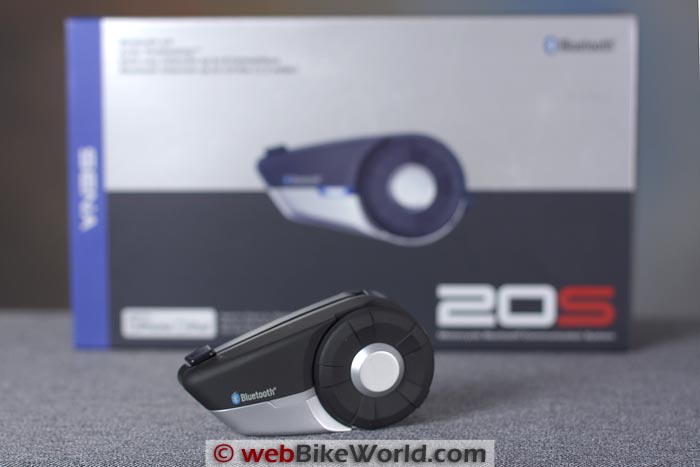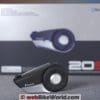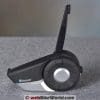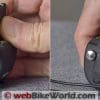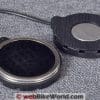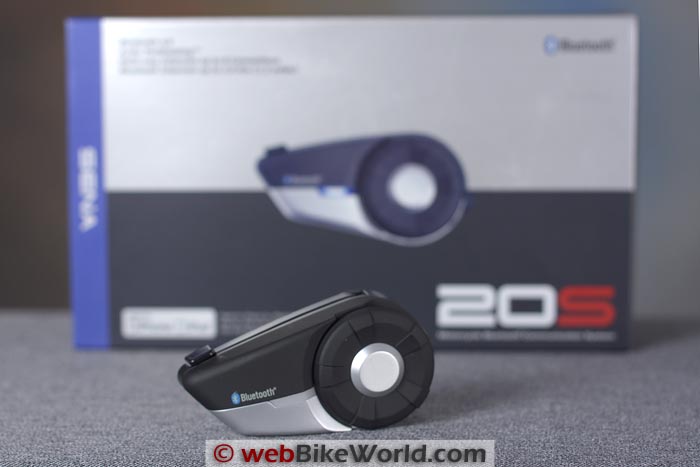Part 1: First Impressions
The Sena 20S is a new addition to the Sena intercom lineup.
It was first introduced in this webBikeWorld Sena 20S preview that was posted during the 2013 AIMExpo (report).
The 20S slides in to the top spot as the new flagship motorcycle communication system for Sena, bumping the very popular Sena SMH10 (review) down a spot in the product lineup.
The build quality of the 20S is a definite step up from the SMH10 and the new system has a more modern appearance.
The famous Sena jog dial, introduced on the Sena SMH10 (review) is still there, but it now has a lower profile.
The 20S also introduces a number of new features, which means it’s a more sophisticated (and somewhat more complex) intercom — or “motorcycle communication system” rather — than any of the other Sena systems.
To accommodate those features, there are three buttons (counting the jog dial). The center “button” is part of the jog dial also.
The additional features and button pushing sequences mean that some of the simplicity of the SMH10 and the Sena SMH5 (review) are gone, but that’s the tradeoff for a more extensive feature set.
What does this mean for new owners? Some serious owner’s manual study time will pay dividends and the “cheat sheet” may come in handy!
But to help you along, there’s a new Sena smartphone app for Android and iPhone and that’s the easiest way to establish or change most of the common settings.
More help is available in a new voice command system on the 20S, accessed by slowly tapping the intercom module twice.
The system is a bit rudimentary and doesn’t always recognize a spoken command, but we expect that to change as Sena releases new firmware updates.
The 20S also now has a flip-up antenna, similar to that found on the Cardo G9 (review). Sena claims a 2 kilometer range for the 20S, compared to 900 meters with the SMH10.
Also, the intercom module now firmly attaches to a new helmet mount. A button at the rear of the helmet mount acts as a release to separate the two.
Sound quality of the 20S remains excellent. The speakers look bigger but aren’t; they have the same 39 mm by 7 mm dimensions as the SMH10 speakers with an added chrome trim ring.
However, Sena told us that they have redesigned the audio system, including the speakers, the audio codec and more. The bottom line is that the 20S speaker sound quality is crisp and clear and even has better bass response.
Sena said they will soon release a new cover for the speakers that will improve sound quality even further.
There are many more features of the Sena 20S to report and this is a first Quick Look first impressions report with some quick photos and video. H.B.C. will follow up in a few weeks with our standard high-quality webBikeWorld comprehensive review covering all the details.
Sena 20S vs. Sena SMH10
The first question I’m sure everyone has is “What’s the difference between the 20S and the SMH10?” We’ll answer that by listing both the new or updated features of the 20S.
Features exclusive to the Sena 20S:
- Bluetooth 4.0
- Built-in FM radio with seek/scan and station presets.
- Dedicated headphone/earbud port on the front of the helmet mount (!).
- Group intercom function.
- Sena smartphone app (Android and iPhone).
- Audio multitasking (music or GPS instructions play under the intercom conversation; volume can be adjusted).
- Voice command system with adjustable “motion sensor”; tap twice on the intercom module to activate.
- NFC (Near Field Communications) allows “tap and pair” with other NFC-enabled Bluetooth devices.
- Ambient mode: press a button on the headset to hear sounds and conversation outside of the helmet (overrides internal connections).
Updated Features of the Sena 20S:
- Low profile jog dial acts as a button and the phone button on the rear.
- 13 hours of talk time and 10 days standby time (claimed). SMH10 has 12 and 10.
- 8-way multi intercom. SMH has 4.
- 2 km distance for the 20S compared to 900 m for the SMH10.
- Can be paired with up to 9 Bluetooth devices. SMH10 has 3.
That, in a nutshell, is pretty much all you need to know about the differences between the SMH10 and the 20S.
In the Kit
The Sena 20S is available in single kits or a dual pack with two complete intercom units. A single kit consists of a 20S intercom module and a helmet mount with boom mic and speakers.
Also included is an additional wired boom mic; a wired mic and a stick-on helmet mount (if the clamp doesn’t fit your helmet).
An AUX cable; a USB cable (used for charging or a standard Android-type mini-USB phone charger will work, as does the Solar JOOS charger (review) that we use quite frequently to charge all our devices) are also included.
You also get a couple of ear pocket pads, some speaker hook-and-loop stickies and an accessory outlet charger.
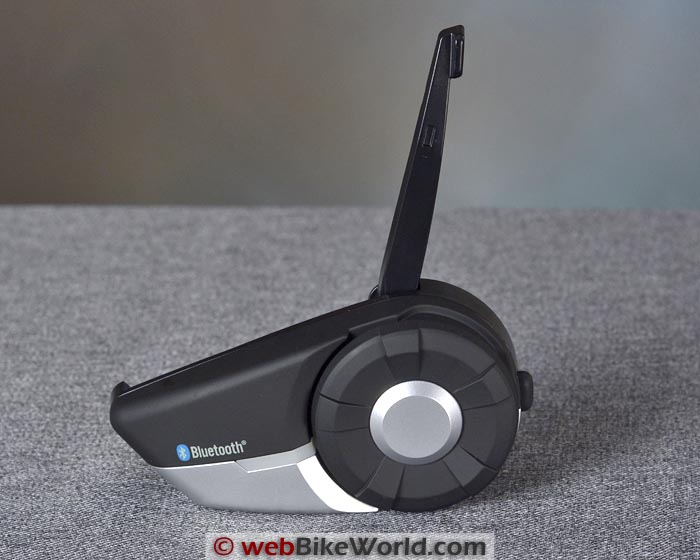
First Things First…
The very first thing you should do when your 20S arrives is download and install the most recent version of the Sena Device Manager on your computer, then install the most recent firmware for the 20S (currently 1.1.1).
Even if your 20S is brand new and has the 1.1.1 firmware, update it with the current version.
Since this is a brand-new product with new features, there are admittedly a few rough spots. You can send an email to Sena support or enter a bug report in their forum and they’re very good about addressing the issues.
For example, on our systems, the spoken status announcement voice is barely audible most of the time, but then comes on very loud in some instances, like when the FM radio is engaged.
Also, the FM radio reception on our units is poor; Sena is working on a firmware fix.
Sena has told us that a new firmware version will be coming soon and the company is very good about releasing new firmware to fix issues and even to provide serious upgrades to the intercom systems.
So it’s best to get used to how the Sena Device Manager works and get on their mailing list to keep updated on new releases.
Sena 20S Photos With Descriptions
Let’s take a look at some photos and we put together a quick “first look” video below, then we’ll summarize our first impressions of the 20S after spending a few intensive days with the systems.
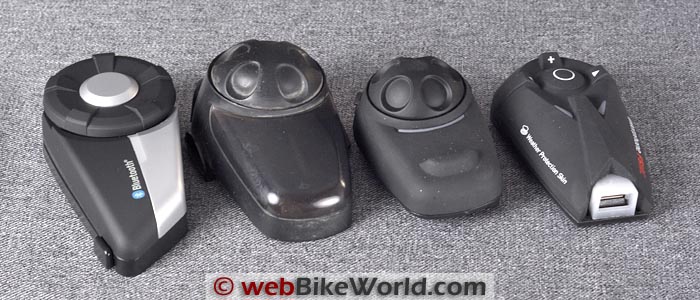
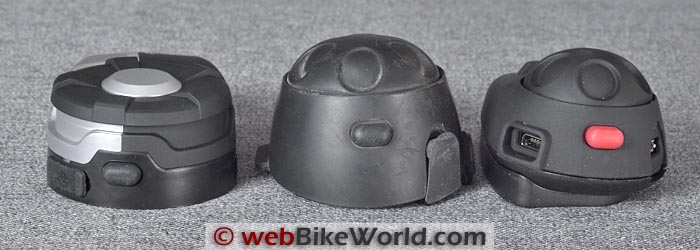
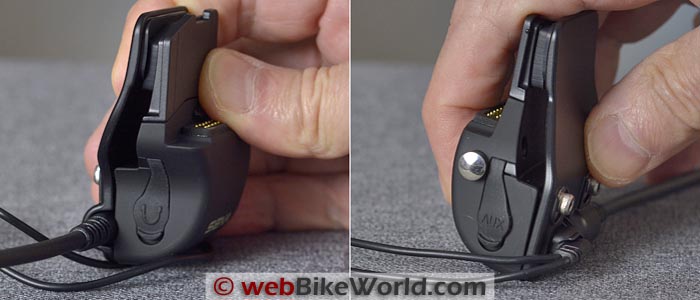
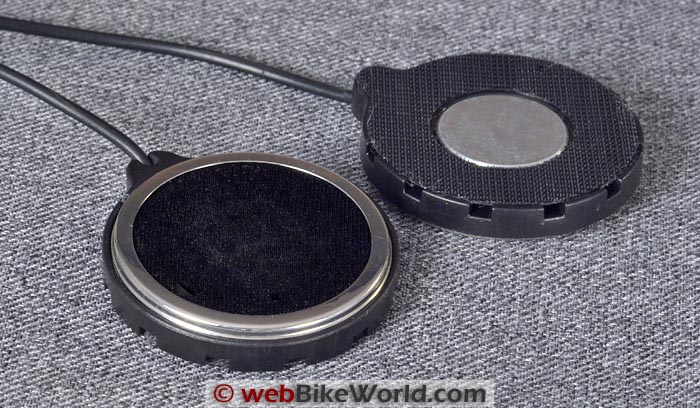
Initial Ride Report With Observations
Read the Manual!
After you’ve downloaded and installed the latest firmware updates, new 20S owners will surely want to spend some time with the printed (thank you!) or .pdf (available here) owner’s manual to learn about all of the new 20S the features and how they are implemented.
We actually spent about 5 hours studying the manual and trying everything out to get it embedded in our little gray cells.
As an indication of the relatively greater complexity of the 20S, Sena has posted a series of instructional videos on YouTube that explain how to use the different features.
We’ve only had a couple of days with the new 20S intercoms, so these are some random quick first impressions that will be followed up with our standard detailed review and report after we spend more time with the systems.
Build Quality
The build quality of the 20S intercom module and the helmet mount has been upgraded from the SMH10.
Besides the more modern look and feel, the 20S now connects to the helmet mount with flat contacts, rather than the pins used on the SMH10 that caused many owners (including us) headaches as they tended to break over time if the intercom module was removed and replaced from the helmet mount too frequently.
Microphone(s)
The new microphone is very nice; it’s on a firm-but-flexible boom that looks like it will last.
It has a sort-of ’50’s science fiction rocket ship shape, complete with a little fin or rudder on the front that you can feel that indicates which direction the mic should point.
The kit also comes with a wired boom mic; the wire leads from the port on the helmet mount to the beginning of the boom.
A stickie at the beginning of the boom can secure to the inside of the chin bar or helmet and then the mic bends towards your mouth. A wire-only mic is also provided.
Pairing
We tried a couple of methods of pairing the 20S with a couple of Android phones. The NFC system works well; first initiate NFC on your phone and then tap the body of the intercom module on the phone to pair.
We found that a tap works but a light touch or contact does not. It also means that the 20S intercom module will have to first be removed from the helmet mount to get the systems close enough to pair.
On some smartphones, first enable Bluetooth and you may still have to select “Search for devices”.
That’s probably the easiest way to pair the 20S with your phone, although the standard method works. Don’t forget, there are two types of pairings: pairing with another Sena intercom and pairing with a Bluetooth device each take a different button push on the 20S to engage.
Note also that pairing the 20S with a Sena SR10 Bluetooth adapter (review) involves a slightly different procedure, as described in the 20S owner’s manual.
You can also selectively pair the 20S for A2DP only or HFP (hands-free protocol) for cell phones only, but most owners probably will not need those pairing types.
Voice Commands
The basic voice command system in the 20S is supposed to activate when you say “Hello Sena” with the 20S in standby mode. We couldn’t get that to work but the secondary way to start the voice commands is to tap the intercom body (not the jog dial) twice.
You can then navigate through the menu system but the system didn’t always recognize our commands; some of the commands have to be spoken slowly and distinctly to be recognized.
The best way to set up the 20S is through the smartphone app.
If you don’t use the smartphone app to change the setup, some of the menu choices don’t let you back out of the sub-menu to the main menu. You can only exit the menu system entirely, then you have to navigate back down.
This is the case with the “Overlay Sensitivity Mode” menu, which allows you to set the background volume for Audio Multitasking (music continues to play in the background when you’re on the intercom).
You have to jog through 10 choices to get to “exit”, but “exit” in this case means exiting completely out of the menu system, rather than up one level to the main menu. Sena said they’ll fix this in a firmware update.
The configuration menu can also be accessed by the somewhat confusing procedure of pressing and holding the jog dial for 12 seconds, a long time.
The 20S will first announce that it’s going into pairing mode, but you have to keep holding, then you get two pairs of beeps, then finally it enters the configuration menu.
Sena may have tried to do too much with too few buttons; it would probably be better just to stick with the easy-to-use smartphone app for all settings.
Owner’s Manual
A couple of things are missing from the owner’s manual; one is that it doesn’t explicitly tell you how to charge the intercom units! It’s simple actually; you can connect to a standard mini-USB cell phone charger or charge it via the included USB cable using your computer.
Music Streaming
One quirk that we think is smartphone-related is that if you have the smartphone set to resume music when it re-connects with a previously paired device, the last tune that was playing (or the next) will resume.
It’s a little annoying because you may not always want the music to immediately start and to pause it, you have to press and hold the jog dial for 2 seconds each time the intercom re-connects.
In other words, the music is always either playing or paused in the background. The smartphone settings can be changed to stop it from resuming the last stream, but if we did that, then we couldn’t get the music to stream to the 20S again at all.
Perhaps there is a setting that Sena can change in the 20S via firmware to choose whether to resume the stream or not after the unit re-connects?
Music Sharing
This is where remembering all the correct button pushes will come in very handy. See this SenaYouTube video which explains the procedure to initiate music sharing.
We found that music sharing has better performance with the antennas in the up position on both intercoms. By the way, Sena has a series of instructional videos for using the 20S in theYouTube Sena User’s Guide.
Audio Multitasking
The 20S allows streamed music, the FM radio and/or GPS commands to be heard over the intercom conversation or vice-versa.
Users can set a volume range from 1 to 10 for the background streams by selecting the “intercom audio overlay sensitivity” setting in the configuration menu (with a few quirks; see the “Voice Commands” section above).
From the manual, p. 42: “The overlaid audio is played in the background with reduced volume whenever there is an intercom conversation and will return to normal volume once the conversation is finished.
If this feature is disabled, any incoming or outgoing intercom will interrupt your audio channel.” The volume of GPS instructions can also be set to take precedence over other streams in the “Navigation App Support” setting.
Conclusion
The new Sena 20S is a significant upgrade to previous Sena motorcycle communications systems.
It has a better tactile and visual presence than the SMH10 which, by the way, will continue in the Sena lineup and will be updated at some point in the future.
The 20S is loaded with features and it is a direct response to owner feedback.
webBikeWorld readers who have requested features like a headphone port, music sharing and streaming without interruptions by the intercom conversations, better range, better sound quality and more.
Sena will be releasing the SMH3 soon also (similar to the Sena/Nexx SXCOM (review)), so we’re seeing a divergence in the intercom space with very simple and easy-to-use “basic” intercoms like the SMH3 and the “high-end” feature-laden “motorcycle communication systems” like the 20S.
We’ll have a full detailed review of the 20S coming in a few weeks after we put it through the paces.
NEXT: Details and Features
Sena 20S Review: Preview | On the Road (Part 3)
Owner Comments and Feedback
See details on submitting comments.
From “H.S.” (October 2015): “Long time reader, second time commenter. As usual, I checked out your website before purchasing a Sena 20S and saw that the FM radio was a bit flakey.
I threw caution to the wind, as I live in a metro area, and that wasn’t the greatest choice. Since I had no plans on returning it, I decided I would find a way to get a little more out of the FM radio in this unit.
And now, the comment I’d like to share: I was able to greatly improve my FM reception by a couple simple modifications.
Living near Seattle, I expected good reception in the metro area, but I was incorrect. I had one stretch of my commute during which I’d lose reception every time.
Here’s what I did to take it from unlistenable some of the time to perfectly clear all of the time:
– If you haven’t already, run your speaker wire across the top of the helmet.
– Take about 10” of thin gage wire, strip away a small section of the insulation in the center and then wrap the wire around your speaker wire so that you have a “+” at the top of your helmet.
– Buy a roll of 3M aluminum foil tape (used to seal HVAC ducts) and cover/secure all of the wire with it.
Unfortunately, I did them at the same time so I’m unsure which change made the biggest impact.
So far so good and it was really easy to do! Hopefully that’ll help my fellow 20S users that upgraded from the 10 for the same reason….the FM radio!”
From “T.U.” (August 2015): “After reading your review of this intercom, my brother and I purchased a Dual 20S set. I’ve been using mine almost daily for 5 months and like it, but there is one major and one minor problem I would like to mention.
1. My mounting cradle and the Bluetooth unit became loose when locked together. This allowed static and total loss of communication between the cradle and the unit.
Lucky I had purchased a separate helmet mounting unit and replacing the cradle fixed this problem for now. I no longer remove the Bluetooth unit and always leave it on the helmet. You can still recharge the battery while its still mounted on the helmet.
2. When I pair my unit with my smartphone, no matter how I try, I can’t get my iPod to play through my 20s unless I use the plug. Stereo music will play through my smartphone, and my intercom and phone calls work just fine this way.
When I have my iPod plugged in, I can’t call or receive calls. Intercom volume is almost too low to be practical also, so my iPod stays home.
This is a problem for me since I have 108 GB of music on my 128 GB iPod, and only 64 GB of memory on my Android phone.
I like this unit quite a bit, but build quality needs improving. I really like the Android app too.”
From “H.S.” (June 2015): “I’ve been following your site since 2009 — LOVE it, it was really helpful for many product reviews over the years.
Now, I did get the SENA SMH10 from day one (generation 1 model too which I upgraded to the current SMH10 model). Last year I upgraded to the SENA 20S.
Its been nearly 1 year since I had the headset and I am shocked at how many people are reporting issues and problems with the SENA 20S and how Sena Customer support has been dealing with it. Its almost night and day — some people are getting great customer service, and others are getting the the run around.
These incidents are not isolated, but on many different websites and even the SENA community support forum.
I have the 20S and it seems to work ok, but the FM Radio reception is spotty and I am worried for the build quality. I am only holding on to it as I got it for a deal, but seriously was thinking of going back to the SMH10.
Cardo systems have their Packtalk product coming out soon, but its even more $$$ than the Sena model.
What the point of this note is to point out that its not all roses for new 20S owners. SENA really dropped the ball and I and many others are reluctant to support them in the future.
Also, worth noting, that warranty terms and conditions changed for SENA. You need to pay for your shipping back to them or their reseller if you have issues with your device.”
From “M.M.” (June 2015): “Thank you so much for providing the review on this product. I really liked the way you have explained things. Also I was having issues paring Universal Pairing mode, the way you explained it…I got it work… Thank you so much !!!”
From “C.R.” (May 2015): “I read your review of both UClear Bluetooth headsets and the Sena 20S. You mentioned about how the Sena 20S would connect with the UClear 200, but the UClear had no control over the connection.
What about if you used the UClear as the “master” (or whatever it would be called)? If the UClear initiates the connection, would that allow both to have control over when they could talk?”
H.B.C. Replies: “At the time the evaluation was written and posted, and given the firmware versions of both the 20S and the UClear HBC200, only one of the two could take the Lead or ‘master’ role in setting up Universal Pairing between the two devices.
And only the Lead could subsequently initiate a universal pairing session, although either party (Sena or UClear) could end it.
Bottom line at the time: the ‘Lead’ role couldn’t be shared between two headsets, which made sense given switching and priority rules using a single Hands-Free Profile (HFP).
As way of update testing, I used a Sena 20S (firmware v1.4) and the UClear HBC 200 Force running firmware v2.15 (haven’t been able to get v2.19 to load yet, an ongoing issue).
With this baseline, putting the Sena 20S into its Universal Pairing mode and then the HBC200 into its Cross-Brand mode results in the two headsets pairing in 35 to 45 seconds and a couple of seconds later a universal intercom session will be live between the two — so far, so good.
But in this configuration, the Sena 20S — despite being the ‘lead’ (sort of) — could not end or start a universal session but the HBC200 can do both, so it becomes the ‘lead’; a point made in the UClear User Manual.
All pairings were deleted/systems reset between configuration exercise.
But no matter whether the Sena 20S or the UClear HBC200 was made the lead for pairing, only the HBC200 ended up being able to initiate or end a universal intercom session.
For the record, audio is extremely good and even at extended range. So the results now are obviously different than originally discovered/used and the tables have turned so to speak; a bit curious.
Needless to say, some more testing of the universal pairing capabilities of various systems will be done, particularly appreciating most have undergone one or more firmware changes and sometimes the tweaks are identified, sometimes not.
Bottom line in response to the final part of your question: the Sena 20S can be used to set up the whole thing, but at this point in time only the UClear HBC200 can be in control (initiate/terminate) with the Sena 20S seemingly just along for the ride.”
From “B.W.” (May 2015): “I purchased one of the first Sena 20S available.
Have had Scala Rider G4, G9 and Sena SMH10. The 20S works ok, it is a bit quieter as far as wind noise, however the range is not good at all. I would say less than 1/2 kilometer.
I advised Sena of this and they said to return the unit to them for repair/replacement, in the middle of summer when one needs it. Oh and I have to pay for shipping. I have updated the unit with the latest firmware.
I guess I will try to utilize it for the summer and switch back to a Scala Rider product as they do work just as good and have far better range.”
From “L.V.” (May 2015): “I purchased a 20S based on my excellent experience with the SMH10 which I owned for a couple of years until I broke it by dropping my helmet on it (damnation!).
A key reason for purchasing the new 20S was the radio functionality.
Unfortunately I have found like many other customers who have posted on their support forum that unless I am fairly close to a transmitter the reception drops out…
While disappointing and nowhere up to the standard of a Caddo Scala unit I borrowed last week, I can live with the near useless radio. But recently the unit often won’t turn on and if it does it then has a variety of strange behaviours.
It intermittently won’t pair with my phone or It intermittently turns back off within 20 seconds No matter what button you push it just says ‘intercom failed’.
In dialoguing with Sena’s support staff (and going through the factory reset, new firmware upload procedure) they have diagnosed the unit is faulty and needs to be returned for repair/replacement.
Because I purchased the unit in the USA but am now resident in another country Sena has requested that I pay the full cost of returning the unit to them including Korean customers charges and reimburse them for the cost of returning the unit to me.
They have even pointed out this is as per the new warranty posted on their website.
However this is not as per the terms of their warranty in the manual that came with the unit at the time of purchase, pages 63-66 (Also the same as their current manual on their web site).
I have advised them I was happy to pay the return cost to them but of course expected them to meet the cost of returning the unit to me. It is unlikely that anyone else will end up in my predicament but I feel their response is indicative of their commitment to looking after their customers.”
From “K” (April 2015): “My four friends and I received our Sena 20S units only a few days before our almost 5,000 mile tour of Arizona and Utah National Parks trip. Looking back, many of the issues we experienced were probably due to the steep learning curve of the 20S system.
Sena since acknowledged many issues and addressed some of them with firmware changes and/or replacement of the hardware (units) with newly-designed units.
Sena replaced all four of our units due to FM radio reception problems and unit-to-base mounting failures. The quickness and efficiency of Sena’s replacement needs to be commended.
Sena does have some of the best customer service of any company that I’ve ever experienced. But some issues still exist.
1. Top on the list is that the units will intermittently power themselves down without any warning or announcement.
When it seems that one’s 20S friends have become silent; it was surprising to find that my unit had powered itself off.
When I tried to cycle the power to try to correct the silence with a power-down, I discovered that the unit WAS off! In other words, when I reached up to turn it OFF, it turned it ON; it was already off.
This happens quite often; and is very intermittent. There are dozens of users complaining about this issue and hoping it can be corrected with a firmware update.
2. Next on the list is the fact that Sena has decided that phone calls and GPS driving instructions are more important than intercom communications. This is a biggie. Whenever the GPS powers up, beeps, or gives a routing instruction, intercom communications are lost.
What happens on the road is this: When any 20S user’s GPS gives a routing instruction, intercom is disabled.
That makes it impossible for riders to communicate very important routing from motorcycle to motorcycle via the intercom. In other words, when we need intercom the most, it is disabled.
The Sena 20S forum is also packed with contributions asking Sena to please give the user the ability to customize the priorities in their units.
Now, I must add that this is the case when the GPS is paired and connected as the ‘first phone’ as described in the manual in order to enjoy stereo sound from the GPS’s other functions (XM radio, MP3, and Audio Books).
3. Speaking of the manual, it does a good job of instructing how to configure the 20S’s many capabilities; but it doesn’t mention why one scenario might (or might not) be preferred over others.
For instance, one must learn by experience that when the GPS is paired as ‘First Phone’ to the Sena, the GPS will block out intercom communications.
We had to learn this on our own. 70 MPH on the highway is not a good learning environment. Either the Manual or Sena’s on-line presence should explain all of the ins and outs of the unit.
4. Intercom connections are confusing. If I connect to Mike first (for instance), Mike is my #1. If I connect to Dan next, DAN becomes my #1 and Mike my #2. If I connect to a #3 friend, he/she becomes #1 and previous connections all move up a number.
And so on with #4 friend, #5 friend et al. Each new friend becomes #1 and all the rest move up a number.
And somehow, the friend number must be memorized while traveling down the road. This really makes for a lot of confusion when each member of the group connects to each other member.
Everyone will have communication with everyone else; but it’s almost impossible to figure it out without keeping written notes.
5. Sena gave me clarification regarding stringing users together. Each 20S can only connect to two others for intercom communication.
But each of those two others can connect to one additional user, each; making the string contain four users that can all communicate with each other.
Each of the new users (on each end of the string) can connect to one additional user, each; making the string contain six users.
Now here’s the rub: If User number 2 runs out of battery, goes out of range or experiences unit shut-down (as described above), User # loses communication with #2 and everyone else downstream!
Everyone else downstream can still communicate with each other, but not with #1. And #1 will wonder where everyone went.
Hopefully, the iPhone app will make this more intuitive and connect in such a way that only the one user is lost. Unfortunately, the app didn’t work while we were on the trip.
I understand that they’ve fixed it now but haven’t gotten enough riders together to try it.
6. Using the smartphone app: This means that the smartphone must be connected to the 20S. But the preferred connection is for the smartphone to be connected to the GPS and then the GPS to the 20S.
The GPS has a wonderful smartphone interface that allows calling restaurants, hotels, etc. while on the road as well as anyone in the phone’s memory. The GPS graphic user’s interface makes initiating or receiving phone calls quick and efficient.
So the smartphone must be connected to the GPS and the 20S simultaneously? What happens, then, when the phone rings? How do you keep the smartphone MP3 music from playing every time the 20S powers up? (one of our group experienced that and he couldn’t figure out where the unwanted music was coming from.)
7. Finally, the Harley Davidson radio system cannot be made to connect to any Bluetooth helmet system. Sena has stated on their forum that an interface to Harley and Honda radio systems is a work in progress.
We’ve been waiting a long time. When they do release such a Bluetooth dongle (for 2-way communication to motorcycle’s factory radio system), they’ll be the preferred Bluetooth helmet system source; hands-down for Harley and Honda owners that have factory radio systems.
In conclusion, despite the issues itemized above, I still think that the Sena 20S is the best Bluetooth helmet intercom communication device available.
I’m confident that Sena will make firmware changes and smartphone apps to make it more and more intuitive to use and more reliable. And eventually, they’ll come out with a new model that is even better, I’m sure.
Some day, they’ll have a motorcycle factory radio dongle so I can have my complete system. So I’m sticking with them.
Their 24 month warranty is the best. They have people at their help desk forum that answer questions the same day that they’re asked. The modern Bluetooth units are more complex than ever with features not before contemplated.
But in my opinion, the Sena 20S is the most advanced and has more potential than their competitors.”
From “B.W.” (November 2014): “I just read your review of the 20S, I purchased one recently, prior to this I had Scala G4, G9 and Sena SMH10. I like the 20S so far, however I wonder if you could help me with this issue.
I have an Android smart phone and a Zumo 660 GPS. I have no problem pairing the phone to work through the GPS so I have call display on the screen.
However if I also pair 20S to my phone so I can stream music, I lose the call display function, it seems as though I can only have one or the other, is there a way to have the 20S do both functions: provide call display and be connected directly to the phone.
I contacted Sena and their answer to have this work did not work for me. This is basically the same thing as I had with the G9 .”
H.B.C. Replies: In not knowing which Android phone you have, its flavor being run or the firmware versions of either (all can be applicable), the following steps should address your requirements.
And everything is based on exploiting the Selective Pairing features (Section 6 of the User Guide) of the 20S (running firmware v1.2).
It is a relatively reliable method of getting the configuration I think you want and I have used it on the zumo 660 (software v5.10), zumo 665 and BMW Navigator V.
- As stated in the Guide, it is critical that you clear all previous pairings from the mobile phone, the 20S and, I also delete any related pairings on the GPS device as well.Now turn BT off and on for the phone and GPS and after the clearing routine on the 20S, turn it off and then on again – a clean baseline to start from is good.
- The following Selective Pairing sequences described below may be varied, but I would recommend that you try them first in the order presented below.
- A2DP pairing for media streaming from Phone to 20S: this Selective Pairing process will ‘reserve’ A2DP for use between the 20S and the phone.Turn on the headset, press the Phone button for five seconds until the LED flashes red/blue and multiple beeps are heard, within two seconds tap the Jog Dial, the voice will say ‘Media Selective Pairing’.Search for BT devices on your phone, select the 20S and let it pair. Opening the paired device display should reveal that the 20S is paired for media only. Turn phone BT off for now and turn the 20S off as well.
- Headset pairing between Phone and GPS: this will set up a hands-free link with the GPS hosting the phone. Turn on the GPS if needed, activate BT and tap the ‘Phone’ icon, select ‘Add Device’ to initiate this process.Activate phone BT and when it is shown on the zumo’s screen, pair the two devices (you may have to do the 1234 PIN entry).If the pairing services have been set up properly between the phone and GPS, opening the paired device display on the phone should see Phone Audio and Contact Sharing boxes checked as active and available services on the GPS (for call display). Turn phone BT off for now.
- HSP/HFP pairing between GPS and 20S: this provides the headset only link between the GPS and 20S (as both the zumo 660 and the 20S support multiple HFP/HSP paired devices).Turn on the 20S if needed, press the Phone button for five seconds, after the multiple beeps the voice will say ‘Phone Selective Pairing’. With GPS BT on, use its ‘Audio’ pairing process to pair the GPS and 20S.
- At this point with the pairings made, it is best to turn BT off on the GPS and the Phone. With the 20S on, activate BT on the phone and let the A2DP link between the phone and 20S activate — you can check this by listening to the media stream.Turn on the GPS and activate its BT. If all is well both headset links will activate confirmed on the GPS BT menu screens, along with the small headset icon on the top services display and the larger phone icon on the lower part of the touch screen.
- If you are using the media stream and subsequently activate the other pairings, the music might stop for a second or two, but it should resume once all is sorted out.And even though the Selective Pairing processes used for the Sena device assignments work well, the BT principle of first in/first out applies; letting the A2DP media connection go first is good.
General Points: In doing a lot of testing with these and related devices, I’ve been able to really mess things up regarding profiles and timings, but the Sena devices, especially the 20S sort things out sequentially.
With the zumo 660 and 665, I do find that occasionally the GPS with Phone or the GPS with 20S connection had to be manually initiated at the GPS. With the newer BMW Navigator V no coaxing was needed.
As always, the processes and sequences detailed may not work exactly or as smoothly as desired, so some time spent in trying different implementations is good. And some of us have found ‘shortcuts’ as well, but they don’t always work…
Short Version: All of the information on how to do this is described in the owner’s manual. I went back in some notes and then did some more playing around this afternoon. The following is a more nut-shell or summary of what needs to be done and how.
Objective 1: Phone hosted by GPS for call display/calling purposes, achieved by using Phone menu on GPS to pair, Phone services will be available via main screen of GPS.
Objective 2: GPS to 20S for navigation and phone audio. This can be done in different ways as both the zumo 660 and 20S support more than one HFP connection. But the following two are well defined and always seem to work:
1. By using Selective Profile process described in Section 6.2, for Phone Call Only or 2. using the procedure described in Section 5.4.1 for BT GPS Navigation Pairing.
Both these methods are based on using the ‘Audio’ Bluetooth connection on the GPS as the ‘Phone’ connection is already being used for the Phone and GPS pairing.
Objective 3: Phone to 20S using the process described in Section 6.1 for Selective Profile A2DP stereo audio streaming from Phone media service to headset.
Note: I’ve found that given the 20S multi-tasking capabilities, an A2DP pairing between the 20S and the Phone can be created and typically a second one done between the 20S and the GPS (using Audio menu).
And when the primary A2DP link is not being used (Phone media service to 20S), the second A2DP link can or will be activated allowing stereo music streaming and navigation and phone audio from the GPS.
The key here is to know what profile support features each device has and where multiple or simultaneous connections are allowed; most newer devices allow more configuration and use flexibility and spending time playing around really does pay dividends.
From “L.S.” (October 2014): “In Sena 20S Review (Part 2), you talk about firmware v1.2 RC8 and RC11 releases. On their website I can find only one version of the v1.2 . How can I understand which release I’ve installed? Thank you.”
H.B.C.’s Reply: In the Part 2 review, I just mentioned the unofficial pre-release firmware (typically marked as Release Candidate (RC) or Beta) to identify that we had received and worked with all the firmware whether it was a formal release or not.
Unless the manufacturer posts other information or makes other not-yet-released firmware available (which should always be clearly identified as such), always go with the current firmware posted, in this case Version 1.2 which is the current official release.
And with the latest Sena Device Manager installed, with the Bluetooth system connected and recognized, the current firmware will be read and shown in the upper right of the screen — the App provides the firmware info as well in the centre section of the opening screen. Once any update has been applied successfully the new version will be shown.
As long as you can connect to the PC application or the smartphone App, you should always be able to tell what version is being run.”
From “T.G.” (October 2014): “What about durability? The Sena 20S forums are full of people complaining that the helmet latch is breaking and not holding the unit to the helmet anymore, some resorting to rubber bands.
Also, there are reports that the body is splitting in half. How many times have you removed the unit from the helmet and replaced it? Have you noticed any difficulty or premature wear on the attachment points? Have you broken the latch yet?
I was going to pull the trigger to buy a dual set until I saw the flood of reports that the latches are breaking easily.
Thanks a ton for doing these reviews, I am glad they fixed a lot of problems in the recent updates, and hope they fix all the problems before I buy a set in the spring.”
H.B.C.’s Reply: This, so far, isn’t an issue from my perspective, but I do acknowledge that some individuals seem to have had problems, but in sitting on the forums, I can’t say I’ve seen a “flood” of reports.
In using two of the original Sena 20S chassis/bases for four months now and in having moved them between a total of six helmets (two using adhesive mounting and four using the clamp), I have not had any issues related to breakage, premature wear, etc.
The adhesive mounting plate is not as strong as that supplied with other brands, but neither of them has failed, although with the SCHUBERTH C3 fitment I added a small narrow strip of 3M adhesive to fill in the height differential between the shell and the base pieces of the helmet for better surface contact.
I did have initial concerns over the boom microphone unit, but the booms as used on the flip helmets have held up just fine and so far, no wear or tear is evident.
If any issues had been experienced, they would have been identified in the review.
Regarding the concern that “body is splitting in half”, I’m not sure where or how the body would split in half unless where the molded pieces join and held with the fastening screws that need to be removed to change microphones or remove the speaker connection.
I do know of one user who had done this and not reassembled the base properly, so the base/clamp pieces did separate (thankfully nothing was lost or damaged), but this was an installation-related issue and from what I saw not attributable to premature wear.
As mentioned above, the clamp (latch?) mounting plate fitments have been working fine. They aren’t of the same weight and bulk of other Sena (and other brand) mounts and admittedly appear lightweight overall.
But, the clamp fittings have been on/off four helmets as mentioned above – numerous times, which the norm for my continuous testing and use activities. I am hard on helmets and installed systems.
I also haven’t had any issues with mounting and locking the module to the base, something that I also originally thought might be or become an issue over time.
From “S.J.” (August 2014): “I your review of the Sena 20S and I have a question related to the features of the equipment.
You have listed as a feature exclusive to the 20S saying Group intercom function and then below it in the upgrades, it says 8-way multi intercom. What exactly is the exclusive feature of Group Intercom?
Thanks for the great initial report and your help. Looking forward to the detailed review.”
Rick’s Reply: I thought someone would ask that question but I was hoping they wouldn’t! I’m a bit confused over it myself. But I asked Sena and here’s their response:
“They are basically same internally. If we look into the topology of the communication, it is based on the daisy-chain. However, it is kind of automatic, so it doesn’t require manual pairing for 8-connections.
Also, it manages a sort of messaging among the device connected to monitor the connections. In short, both are based on the same topology; one is automatic and the other is manual. You know the automatic is not always best, so there is pros and cons there.
Once the Group Intercom is broken or a connection in the middle was disconnected, then you need to restorer the whole connection by automatic Group Intercom. Multi-way intercom? You may manually reconnect the partied disconnected.
A future firmware update will include more versatile Group Intercom as well as adding STAR topology.”
From “M.A.” (July 2014): “Another great review of a new product..thanks for keeping webBikeWorld relevant to what’s up and coming on two wheels.
Has Sena made any changes to the audio (sound) generated when two bike to bike intercoms go out of range? Our first gen SMH10 are still working just fine — they generate static and hissing when we’re at the far end of our range, but the noise is tolerable.
We had tried a newer generation of Sena intercoms, but found the digital noise when approaching max range intolerable (no worries, someone on eBay got a heck of a deal!).
I’d love to try a new Sena long range unit as described in your latest review but would like to know in advance what happens when the range is exceeded. As always a loyal reader…”
Rick’s Reply: I asked H.B.C., who is currently working on the Part 2 detailed review follow-up, and here’s what he told me:
Still going through some initial tests and use configurations with the 20S (nice design and build by the way) and so far in our one highway excursion.
The 20S will drop and then auto-recover any active intercom link, and I didn’t hear much other than the usual atmospherics (the signal weakens initially before dropping out, but as the link is recovered and is completely restored, the noise will be overcome).
Comment: this is (unfortunately) common to ALL Sena intercoms…something seemingly not yet addressed over a few years and releases, whereas other manufacturers — Cardo, UClear and Midland to name three — have pretty much beaten this.
But I think some tuning/filtering tweaks have been done as the usual noises present on the Sena intercoms are much lower with the 20S than say the SMH10, SMH10R or SMH5.


